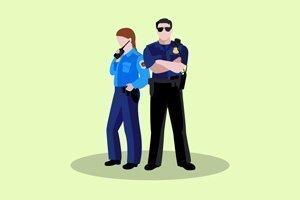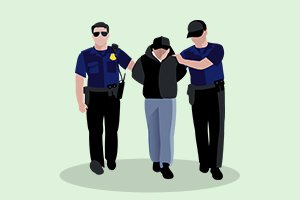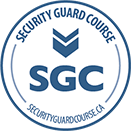Introduction
Given the nature of their role, and the role of private security in general, security guards may be required to use force from time to time. It may be required to protect themselves or others, protect property, prevent crimes, and apprehend offenders. However, it is crucial that security professionals exercise their authority judiciously, keeping within legal and ethical boundaries.
The balance between maintaining safety and order, and respecting people’s rights is delicate. It requires a thorough understanding of ethical guidelines, legal authorities, and real-world implications. This article will delve into the ethical considerations surrounding the use of force by security guards in Ontario specifically, with an emphasis on the importance of proportionality, necessity and respecting human rights. We will also discuss the relevant legal frameworks that apply to a security guard’s decision-making and accountability when it comes to using force.
Understanding the Use of Force in Security
The concept of “use of force” refers to the amount of force that is necessary to compel compliance from an uncooperative subject. This could be for the purpose of gaining, or maintaining lawful control of the individual. It might also be for the purpose of protecting oneself or someone else from physical harm, or protecting property from theft or damage. In Ontario, the use of force by security guards is governed by the Private Security and Investigative Services Act (PSISA). This act sets out the framework in which security guards in Ontario are required to operate within. This includes legal standards, licensing requirements and ethical conduct. The PSISA ensures that the actions of security guards in Ontario are in line with both public safety and an individual’s rights and freedoms.
Security guards routinely find themselves in situations where they must make split-second decisions about whether to use force, and the most appropriate amount for the circumstances. In order to make the best decisions, security guards must be able to quickly and effectively assess the situation. This requires a thorough understanding of their legal authorities and ethical guidelines. The PSISA, Criminal Code of Canada and other legislation provide clarity to security guards, emphasizing the necessity of a measured and justified response in any given situation.
Ethical Principles Guiding the Use of Force
Proportionality
One of the primary legal and ethical principles of the use of force is proportionality. This principle states that the amount of force used by the security guard must be appropriate to the threat being presented. Security guards are expected to assess the situation to determine the least amount of force that will be required to meet their objective in the situation. The use of excessive force can lead to unnecessary injury, violating ethical and legal standards, as well as organizational policy infractions. Violating any of these can lead to severe consequences for the security guard.
For example, consider a security guard who is attempting to arrest a shoplifter who is uncooperative, but not physically aggressive. Using a high level of force such as striking the individual with their knee, could be deemed excessive because it is disproportionate to the level of resistance they are facing. Instead the security guard should seek to use minimal force to detain the subject, such as verbal commands and soft physical control techniques. Proportionality ensures that the response to the threat is appropriate, legal and ethical. It also helps minimize the likelihood of an escalation of violence from the subject, reducing the risk of injury to everyone.
Necessity
The principle of necessity requires that physical force should only be used when absolutely necessary. All other options, such as verbal commands and de-escalation strategies should be exhausted before resorting to using physical force. Security guards should be trained to recognize when force is required and when it is not, as a part of their assessment process. This will help ensure that informed decisions are made, even when under stress.
Consider a situation where a subject is being verbally resistive and confrontational, but not physically violent. In the absence of any immediate risk of injury, utilizing good communication skills and situational awareness might be all that is necessary to resolve the situation, without resorting to unnecessary physical force.
Respect for Human Rights
Respecting the rights and dignity of others is paramount in any situation that a security guard might face. Even when force is necessary, it should be done in a manner that minimizes the risk of harm, and respects the subject’s dignity. This ethical consideration in the use of force is closely linked to several pieces of legislation, including the Canadian Charter of Rights and Freedoms, and the Ontario Human Rights Code.
At all times, security guards must be aware of, and give consideration to, the impact that their actions have of people’s rights and freedoms. For example, when placing someone under arrest and detaining them while awaiting the police, only the least invasive methods required to maintain control of the subject and the safety of others should be used. This approach not only respects the individual’s rights, the ethics behind it also helps to build trust between private security and the communities in which they serve.
Legal Framework and Guidelines
The Private Security and Investigative Services Act, 2005 (PSISA)
The PSISA governs the private security industry in Ontario. It sets out the legal requirements, as well as professional standards. Relating to the use of force, the PSISA’s key provisions include authority, limits to that authority, training requirements, and reporting obligations.
Authorization and Limitations
- Security guards are authorized to use force only when it is necessary for self-defense, defense of others, or the protection of property, and only when there are no other reasonable options available. The force used must be reasonable and proportionate. Excessive force is strictly prohibited.
- The PSISA reinforces the existing legal authorities surrounding the use of force found in the Criminal Code of Canada.
Training Requirements
- Security guards must receive proper training in use of force, and communication/de-escalation strategies. This training will help ensure that the security guard has the ability to manage confrontations and potentially violent situations safely and effectively.
Reporting and Documentation
- Security guards must report all use of force incidents promptly to their employer, and if necessary, to law enforcement. Detailed incident reports must be maintained, accurately detailing the incident, and the circumstances leading to it.
Compliance with the PSISA not only helps to protect the security guard from legal repercussions, it also provides a framework that ensures that their actions are consistent with professional and ethical best practices, which is important for maintaining the public’s trust in the industry.
Relevant Sections of the Canadian Criminal Code
Several sections of the Canadian Criminal Code provide the legal authorities that the PSISA relies on when it comes to security guards using force:
- Section 25: Allows individuals to use reasonable force when acting under a legal authority, such as apprehending offenders. The force used must be reasonable, necessary and for the purposes of control.
- Section 26: Holds individuals criminally responsible for any use of force deemed excessive.
- Section 27: Permits the use of reasonable force to prevent an offense from being committed, under specific circumstances.
- Section 34: Allows individuals to use reasonable force to protect themselves or others.
- Section 35: Allows individuals to use reasonable force to protect their property, or property they’ve been authorized to protect.
These are the primary authorities that permit security guards to use force in the course of their duties, when no other more reasonable options exist. It is critical that security guards understand their use of force authorities, and how to apply this knowledge when assessing any situation.
Ethical Decision-Making in Practice
Ethical decision-making requires a careful assessment of the situation and consideration of the options available, and the potential consequences of each of those options. Security guards must ensure that their actions are aligned with the policies of their employer, their legal authorities and ethical principles governing their conduct.
Strategies for Ethical Decision-Making
- Assess the Threat: Evaluate the level of threat and the urgency to act. This involves observing the environment, the subject’s state of mind and behavior, any safety concerns, and more.
- Considering Options: Explore alternative options to using physical force first. This may include verbal warnings, seeking additional assistance, and utilizing de-escalation strategies.
- Reflecting on Professional Standards: Align actions with ethical principles, the PSISA Code of Conduct, legal authorities and company policies to ensure that they are consistent with professional expectations.
Examples of Ethical Dilemmas
- Handling a Non-Violent, but Uncooperative Subject: A security guard locates and individual who is on the property without permission. The individual refuses to leave when asked by the security guard. When choosing what action to take next, the security guard must consider the individual’s rights, what options are available to resolve the issue, the potential consequences of each option from a legal and ethical perspective, resorting to the use of force only as a last resort. Making the wrong decision, such as using an excessive amount of force on a non-violent subject, could have serious legal consequences, harm the guard’s reputation, along with their employer’s, and undermine trust within the community.
- Responding to a Theft in Progress: A security guard observes someone remove an item from a store shelf, conceal it, and exit the store. The guard must consider the level of threat posed by the subject if approached, the safety of the public, their legal authorities and company policies when it comes to handling thefts. This assessment will help the security guard determine whether to intervene physically, or report the incident to law enforcement and their manager. An incorrect decision, such as choosing to physically intervene when there are safety concerns, without first using their communication skills to try and gain compliance, could result in injury to the subject, legal liability, and questions about the security guard’s judgment and professionalism.
Conclusion
When it comes to a security guard using force, ethical considerations must be applied during the initial assessment process. By considering the relevant circumstances, and adhering to the ethical principles of proportionality, necessity, and respecting people’s human rights, security guards can ensure that their actions are legally and ethically sound. Proper training in legal authorities, such as the PSISA and Criminal Code of Canada, and communication skills will help security guards uphold the highest standards of their profession.
To enhance your skills and ensure compliance with these ethical and legal standards, consider enrolling in our comprehensive Use of Force and Handcuffing course. This course provides training in de-escalation techniques, situational awareness, selecting the appropriate use of force, and more! Invest in you professional development today, and learn to better navigate complex situations effectively and ethically tomorrow.








